Cloudy pool water is usually caused by dead algae or mists of particles suspended in your pool water. The job of a coagulant agent, like clarifier or flocculant, is to clump these tiny particles into larger clumps so that they can be collected by your filter or flushed to waste.
Now, clarifier and flocculant (floc and vac) are two sides of the same coin. Both are types of coagulant agents that accomplish the same task using different routes. The key differences are the time it takes for the reaction to take place and the extra elbow grease needed from you to finish the job. We will discuss the pros and cons and the best times to apply which chemical.
Clarifier
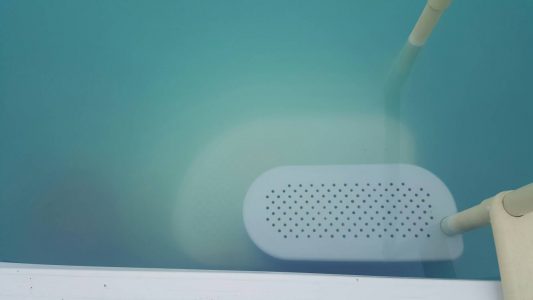
Pros:
- Least amount of work for the user
- Great for light cloudiness and superfine silt
Cons:
- Takes several days to get the desired result
Pool clarifier is a mild coagulating agent that boosts your filter’s cleaning capabilities by clumping small dirt particles into larger particles your filter media can trap. Safe to use with sand, DE and cartridge filter systems, clarifier requires that your pump and filter are run continuously for at least the first 24 hours for optimal results.
Clarifier is a milder chemical than flocculant making for a slower work rate. Your pool’s reaction to the clarifier may take a couple of days before you see the results. So, if you are needing a quick fix for a pool party only hours away, clarifier will not be the choice for you.
Clarifier is the ideal choice for mild cloudiness or a regular part of a cleaning regimen to give your water that extra sparkle.

Flocculant
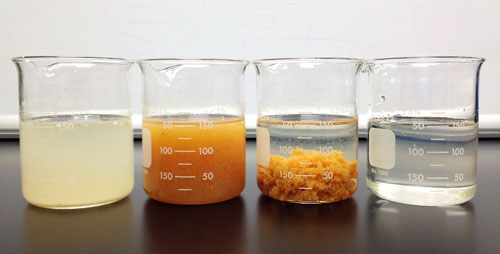
Pros:
- Shows results within a few hours
- Super effective
Cons:
- Requires vacuuming
- Water waste
- Can’t be used on systems with cartridge filters (unless there is a bypass)
Flocculant’s coagulation process is basically a supercharged version of a clarifier. But instead of relying on a pool filter to do the cleaning, it requires vacuuming. Floc clumps the dirt into large clots, so large that they no longer float, dropping all the dirt to the pool floor where you can then vacuum to waste. Your pool should show marked improvement within a few hours of its application, making it ideal for procrastinators (like me) cleaning just before a pool party.
Floc can be used for mild cases of cloudiness all the way up to murky. However, I usually suggest it as a last resort, because you must vacuum it to waste. You can lose a good bit of water while cleaning the pool.
Floc should never come in contact with your filter media as the clumping agent can cause havoc. Floc is only suggested for use with filters with bypass options, i.e. sand and DE filters with multiport or slide valves. It is not suggested to use floc with a cartridge system, unless you have plumbed a bypass for the filter.

So which is best for you?
Clarifier is best suited for basic maintenance, and picking up straggling silt your filter just can’t seem to catch. Flocculant is best for more severe cases, like part and spring cleanup. Flocculant shows results within a few hours, making it great for cleaning in crunch time.
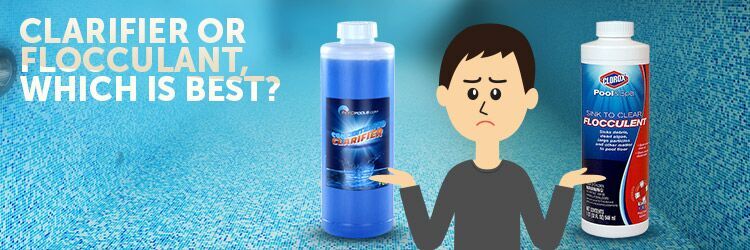
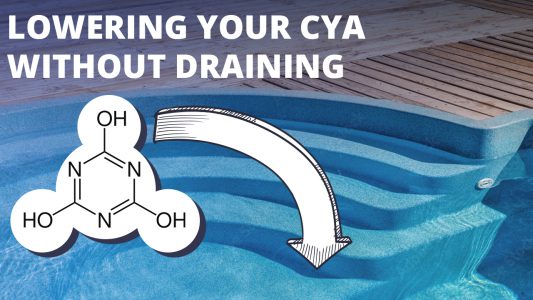
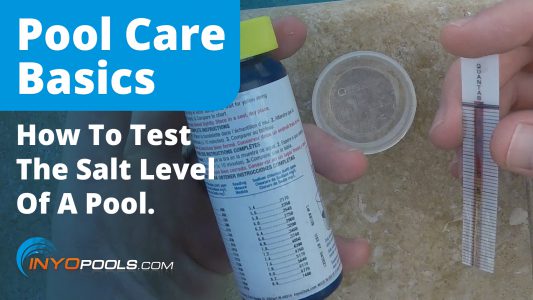
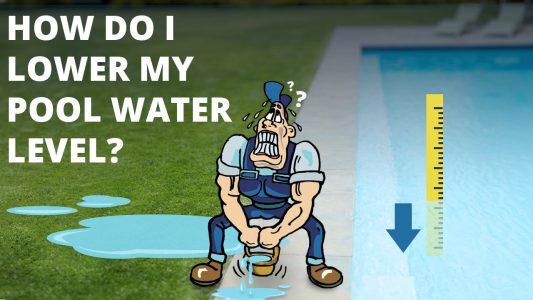
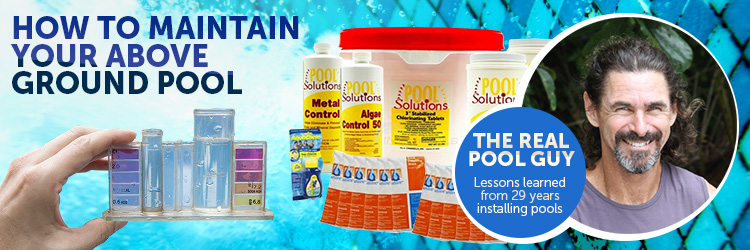






This article grabs your attention by stating that your pool could be clear the next day – with floc and some work. I haven’t found any that required less than 24-48 hours of resting time. Even 24 hours would be great because I’ve never had anything work under 48 hours. Which brand are you talking about? I’d love to see a difference in just a few hours!!!
Hey, these are great tips!
My situation is that we have a mesh safety cover on during the winter which leaves us with a nearly full pool with quite a lot of fine dirt and silt settled on the bottom when it is time to open. Running the Polaris just stirs it up and the mesh is not fine enough to capture it either. So I am looking at using a flocculant and possibly investing in a vacuum that I can direct manually. I have a cartridge filter so running it off the skimmer is not ideal.
So my question is what type (Brand? Model?) of vacuum do you suggest that will either discharge over the side, or into its own canister ?
Thanks!
I use a vacuum head and hose that I purchased from Walmart to siphon vacuum. Submerge your vacuum and hose like you normally would to purge air, then drop the end of the hose over the side of the pool below the water line. Doing this creates a siphon the sucks everything out to waste. You’ll lose a good quantity of water in the process but as least you’ll have the nastiness from the floc product out of your pool!
The Polaris cleaners have a sand/silt bad that is great for fine material. Are you using that attachment? An example of the fine mesh bags is the Sand/silt Bag (280) (k14)
I used floc last night, and it has been over 12 hours that I have not been running the pump. The water is mostly a cloudy blue with pockets of whitish scum on the surface. I still cannot see the bottom of the pool and cannot tell if there is anything on the bottom to vacuum. What do you suggest? Thanks!
Did you let the pump run for few a hours before letting it sit?
I’d let it sit for a few more hours then vacuum to waste.
My pool place told me to use floc last year … me not knowing any better used it not knowing that it can’t be used with a cartridge filter I don’t not have a vacuum to waste option now here we are this year opened my pool today and floc is still on the bottom of my pool HELPPPPPP … WHAT I CAN I DO BESIDES EMPTY MY POOL WE JUST FILLED
Becky,
I don’t have a vacuum to waste option with my filter either but I got around it by creating a siphon vacuum using just the vacuum head and hose.
Submerge your vacuum and hose like you normally would but instead of hooking the hose to suction, drop the end over the edge of the pool (I use a small bungee to keep the hose from sliding around on the top rail while I’m working). This creates a siphon that will accomplish the same goal as vacuum to waste.
Not much. You can try using a sump pump to purge the floc.
Hi Matthew, I used Aluminum Sulfate to floc my pool trying to get rid of high pollen. The pool was crystal clear with globs of slime looking debris at the bottom next morning. I used a Dolphin automatic cleaner to vacuum which was a mistake as it stirred up all the slime debris and now the pool is a blue haze so cloudy. What do I do now? I have a manual vaccum and can vacuum to waste but I don’t know how to attach the vacuum to get suction. My pool has 2 skimmer baskets and I don’t know which side is suction and which is return. Ideally I am wondering if I can add a clarifier and let the filter do the work now or is it too late ?
The suction ports of your inground pool are the main drains, skimmers and some have dedicated suction lines. The most comment way to hook a manual vacuum is connecting a hose through your skimmer. The video and guide on this link will show you how to set up your pool equipment for vacuuming: How To Manually Vacuum A Pool
For now, I would vacuum first, and see how your pool water looks afterward. Also, your pool equipment should valves that can open and close your skimmer’s lines. If you go the route of vacuuming through your skimmer port, try closing the unused skimmer line to increase suction throuwh the hose.
I have a saltwater pool and my pump has a turbo cell. My pump has the waste function so if I put flock in my pool then vacuum to waste, will it mess up the cell???
If this is a standard set for above ground and inground pools, the salt cell should be plumbed in after the filter. So, if the filter’s valve is set to waste, all the water flowing through the pump will go out the waste line and none will reach the cell.
What kind of filter Are you running
To whom are you asking this question?
Hello I have an above-ground Intex pool it’s 52 inch high and 24 foot round I’ve been working on it for about a month-and-a-half and it will not come clear it looks like milk I do not have the waste setting on my filter so I don’t know how I can use the flock could I just backwash it out please help I’m going crazy I’ve wasted hundreds and hundreds of dollars just for all different kinds of chemicals thank you in advance
Backwash allows the water to go through the sand, which is something you want to avoid with flocculant. If your filter does not have a waste function, then I suggest using a clarifier or a product called Pool First Aid.
What happens if you get flock or HTH green to blue in your sand filter, I vacuumed to waste and ran the filter and also then vacuumed it regular, my pool is cloudy and when I backwash the water is clear. HELP
As you probably saw when it was in your pool, flocculant clumps small particles together. Now, imagine what it would do in a big ball filled with water and grains of sand. Not very good for filtering, to say the least.
There is not much you can do other than backwash and hope it clears the flocculant well enough to be able to use that sand again. If not, you will need new sand.
Pop up pool filters are junk. I can’t recommend but I can tell you what I did. Simple modification with a better filter and pump solves the problem. Warrantee is voided yes but you will have better filtration and circulation which means cleaner water. I have a summer waves pool had a Dough Boy pool that was beyond its use kept all filter parts. A short section of PVC pipe, threaded elbow with slip, straight slip with threaded end for adjustable eyeball, and double threaded part for the inside return, out return threaded barb and gaskets inside and outside pool. Cut pool wall for wider opening. Connected return hose to sand filter. Skimmer I lined up inside screw plate held in place with a few screws each side utility knife cut opening attached skimmer housing with gaskets and put my Hayward Pump with Sand Dollar filter together as I normally would. I’m able to use the filter the same as I did with the old pool. My pop up pool is much cleaner than those who use the sand filters that are made for these pools because I can adjust the return lower and it circles around pushing debris into the skimmer. A good pump and filter aren’t cheap but they’re worth it not spending money on chemicals to clean it.
Help! I’m frustrated. I flocked our pool did everything right. Backwashed this morning before work and was amazed at how well the pool went from green to clear overnight. Here’s the big BUT…I planned on coming straight home from work to vacuum and get it back looking fabulous again. But kids came home from gmas and of course, jumped in the pool and stirred it all up. Anything I can do to get it back to the floor to vacuum out? Do I just wait till it settles again or do I need to put something else in?
All you can do is wait for it to resettle.
My system is pump/filter/heater/ return.
How does flocking a pool affect a pool heater connected to a sand filter? The water will be pumped to waste but will go through the heater. Obviously the heater will not be running.
The floc can go through the heater without causing any damage, but I would refer to your specific floc bottle’s instructions to confirm there are no warnings as such. Also, going by your descriptions it sounds like your heater is in between your pump and your filter. Or is your waste line somehow diverted through your heater?
We just had a massive rain that washed dirt from our new gardens into our pool. It’s a muddy mess. My pool store recommended we use Flocculant to clear it up. I have followed the instructions and by 8am tomorrow morning the pump will have been off for 16 hours. I’m hoping it will have done it’s job by then and I can vacuum. My question is: how do you know you’ve removed *all* of th flocculant? If I miss a little bit and turn the filter on (sand filter) will it really damage it? I’m worried I might miss some and cause damage. Thanks so much! Helpful article 🙂
What to buy to clean a cloudy pool or what does it mean to have a cloudy pool
As I cover throughout the entire article, both of these can be used to clean a cloudy pool. Here is a list of reasons why a pool would be cloudy: Why Is My Pool Cloudy?
Floced the pool three weeks ago. Everyday since, I have vacuumed on waste. How long will this go on? Seems like an endless task
The pool shouldn’t need to be flocced that often. What type of debris are you getting rid of?
I’m new to this pool maintenance thing and have been battling a slighlty green and cloudy pool for two weeks now. I’ve added clarifier just two days ago and saw this morning that the algae has settled at the bottom of the pool (when the filter/pump is off overnight). Should I be vacuuming on waste to remove this too? It seems to be very light and just mixes with the water too easily with any motion in the pool. I can also see small cellular looking blobs of green floating around the pool, which I also assume is normal to see when you use clarifier.
I am hoping to have a clear and green-free pool by tomorrow (day 3). How can I expedite that? Can floc also be added in now after the clarifier?
Thanks for any help you can give me – this newbie really needs it!
The only way to clear your up green water is by maintaining high chlorine levels until the green turns cloudy white. The cloudiness in your water mixed with the green water is dead algae. The clarifier is not treating the cause of the problem, so once the clarifier dissipates, the algae are going to pop up. We have this guide that you should follow How to Clean a Green Pool
Can use the flock with high chlorine level?
Yes, you can use flocculant while your pool has high chlorine levels.
This is very helpful. ? Do I add chlorine 1st and circulate water then put in the floc product. Or skip chlorine til after vac/backwash nd bring pool up to right ph
Add chlorine after the floc and vac cycle. You will be dumping a good portion of your water during the floc removal process, which would waste chlorine. If your pH is already low, feel free to leave it, because flocculant raises pH levels anyway.
This is the proper technique of you are opening your pool for spring and there is algae. If you don’t shock it and kill it then the floc.l cannot do its job properly. This is the technique taught by my pool store and I’ve done it the past 8 yeArs.
This is precisely what I needed to know. Thank you for ‘clarifying’ the difference.
No problem, thanks for taking the time to read it.
Matthew.. great information. I just had my pool resurfaced by a highly rated company using Florida Stucco Gem. We paid additional for a two week chemical “fire-up” treatment. After the resurface was complete and the pool was full of water, the company owner came in and began adding the necessary chemicals. One chemical used (as described to me) was intended to mitigate the water cloudiness associated with pool resurfacing that apparently binds these suspended particles with the intent of them making their way to the filter cartridge and, thus, out of the pool. Except the pool man came to the door the next day to tell us the particles were not making there way to the filter as intended and he advised they had to keep moving and not settle. I brushed a couple of times per day, but did not sleep in the pool and certainly couldn’t keep anything ‘moving’ 24 hours per day. The pool man recommended we replace our filter/cartridge assembly as the one we had was old in his opinion and not working well enough. We agreed and he came the next day to install a new one. As was known from the beginning of this process, we have no operable main drain.
The next week while taking a swim in my newly remodeled pool, I noticed what appeared to be a 6 inch white spot at the bottom of the pool near the inoperable main drain. I went down to inspect and the area is very porous and not smooth like the area surrounding it. I noticed other similar, smaller areas with the same issue/defect. We asked our pool man about it and his answer was we didn’t keep the coagulated particles moving well enough, some rested on the bottom which damaged the new surface, but nothing can be done at this point. I was floored. Does any of this sound accurate. I am at a loss as to what to do. Please advise, if possible. Sorry for all the words.
First, i would check any paperwork the installing company provided to confirm the aftercare chemical treatment was to be complted by the company or if it was your responsbility. If it was their responsibility and the source of the problem is their malpractice, then they should be responsible for repairing the pools urface.
If the aftercare was down to you, there should have been a procedure sheet similar to this:
Yes there should have been something like
Day 1 – Add 1/2 gallon Muriatic Acid (careful not to breathe the fumes) Let the Pump run 24 hrs a day for 3 days.
day 3 – Add 1/2 gallon Muriatic Acid then Brush the Pool in the AM and again in the PM. Always clean the filter after each brush. This helps the Plaster rid the calcium.
Day 4 – Take a Pool water sample to local pool store for Testing and do accordingly.
Day 5 – 30 Brush 1 time daily and always clean filter after
This is just for the first 30 days.
They could spot treat that spot with acid using a PVC adapter
https://www.poolzoom.com/jandy-stainmaster.html?keword=&gclid=EAIaIQobChMIuKu__P3s3QIVEYvICh1_zwOCEAQYAyABEgKgVPD_BwE
Thank you.
Does this product have cholrine in it
Not that I know of. But, you can always read the labels before buying some to make sure.
Very helpful article. Thanks for posting!
I worked on my pool for 3 weeks last spring trying to clear the water when I opened my pool. I finally researched online & discovered a ‘floc’ product I had never used. WOW!… I had my pool sparkly clear in one day. I did have a lot of water waste from vacuuming but so worth it! I plan to use this process every spring when opening my pool then use clarifier to maintain. Very good article. I wish I had read this last winter.
Thank you, Linda.
Can you provide the product name?
I need the products name also. Thank you
I just bought and used HTH Floc from Walmart. Did the trick for me and turned my pool clear after I put in the recommended amount overnight (dropped all the debris to the bottom).
Linda, ER/RN
May I have the name of the product you found?
name of product
Dang, my floc said to use “up to” 3 times the recommended dose of 8-oz. per 10k gallons. My pool is 10 k, that would make 3 times the dose 24-oz. I mistakenly added 32-oz. Did I create a problem by adding 4 times the recommended dose?
Using too much floc may cause your pool to become cloudier, and a lot harder to clean. you will have to continue the process of removing floc as you normally would.
You will also want to keep an eye on your pH, because certain types of floc can make you pH take a nosedive.
Hi, I used flocculant as part of opening this season, had all the levels correct. I’ve used it in the past, have a sand filter, bipassed it. Everything like you should, it has only sat about 9 hours as I put the flocculant in kind of late last night…do I still allow it to sit all day or will the sun cause some havoc on the pool without the filter running for the day? (The water is not yet clear, it still looks like it’s collecting white debris together? ) TY so much!!
I would stick to the instructions on the bottle. If it says to let it set for 18-24 hours, do so. Especially if your water is still cloudy, it’s still got work to do. If your chlorine takes a hit then you can just shock it once the flocculant has been removed.
Can hth drop out floc be used in vinyl liner pools?
Of the flocculants I am familiar with they can be used with vinyl pools. But refer to the bottle directions just to be sure.
I mistakenly used flocculant with a cartridge filter so all it does is circulate the debris and make the water cloudy only to resettle again after the pump stops.
Can you advise how to fix this problem?
Flocculant would usually gum up the cartridge making water flow drop and filtering extremely hard. So, not only would water find it hard to get past your filter, so would any dirt. I believe your cartridge became so gummed up with floc that backpressure caused a tear or two allowing the dirt to bypass the filter. You will need to remove the cartridge and examine it for rips in the fabric and broken bands.
Thank you very much for all these insightful articles. All the mysteries unlocked for a novice.
thank you for your information!!!